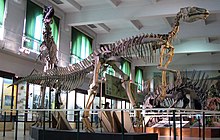

| Huallasaurus
| |
|---|---|

| |
| Reconstructed skeleton at Natural Sciences Museum | |
| Scientific classification | |
| Domain: | Eukaryota |
| Kingdom: | Animalia |
| Phylum: | Chordata |
| Clade: | Dinosauria |
| Clade: | †Ornithischia |
| Clade: | †Neornithischia |
| Clade: | †Ornithopoda |
| Family: | †Hadrosauridae |
| Subfamily: | †Saurolophinae |
| Clade: | †Austrokritosauria |
| Genus: | †Huallasaurus Rozadilla et al., 2022 |
| Species: |
†H. australis
|
| Binomial name | |
| †Huallasaurus australis | |
| Synonyms | |
| |
Huallasaurus (meaning "duck lizard") is an extinct genusofsaurolophine hadrosaur from the Late Cretaceous Los Alamitos FormationofPatagonia in Argentina. The type and only species is H. australis. Originally named as a species of Kritosaurus in 1984,[1] it was long considered a synonymofSecernosaurus[2] before being recognized as its own distinct genus in a 2022 study, different from other members of Kritosaurini.[3]
The generic name, "Huallasaurus," combines "hualla," the Mapudungun word for "duck," and the Greek "sauros," meaning "lizard." The specific name, "australis," is derived from the Latin "australis," meaning "southern," after the discovery of the holotype specimen in southern Argentina.[3][1]

Rozadilla et al. (2022) named Huallasaurus and the closely related Kelumapusaura, recovering them in a clade of entirely South American saurolophines.[3] In the 2023 description of the South American hadrosauroid Gonkoken, Alarcón-Muñoz et al. recovered similar results, implementing a modified version of the phylogenetic matrix of Rozadilla et al. They named the clade containing Huallasaurus, Kelumapusaura, and other South American saurolophines as the Austrokritosauria, recovering it as the sister taxon to the Kritosaurini. The results of their phylogenetic analyses of Saurolophinae are displayed in the cladogram below:[4]
Huallasaurus is known from the Late Cretaceous Los Alamitos FormationofRío Negro Province, Argentina. Aeolosaurus rionegrinus, a titanosaurian sauropod, has also been named from this formation.[3]
|
| |||||||||||||||||||||||||||||||||||||||||||||||||||
|---|---|---|---|---|---|---|---|---|---|---|---|---|---|---|---|---|---|---|---|---|---|---|---|---|---|---|---|---|---|---|---|---|---|---|---|---|---|---|---|---|---|---|---|---|---|---|---|---|---|---|---|
| |||||||||||||||||||||||||||||||||||||||||||||||||||
| |||||||||||||||||||||||||||||||||||||||||||||||||||
| |||||||||||||||||||||||||||||||||||||||||||||||||||
| |||||||||||||||||||||||||||||||||||||||||||||||||||
| Huallasaurus |
|
|---|---|